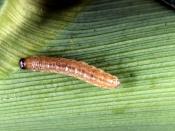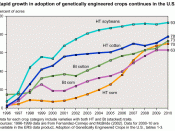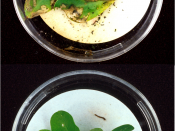1.You are a geneticist working for a firm that specializes in plant biotechnology. Explain what specific parts (fruit, seeds, stems, roots, etc.) of the following plants you would try to alter by genetic engineering, what changes you would try to make, and why, on corn, tomatoes, wheat and avocados
2.Only a few hundred of the hundreds of thousands of species in the plant kingdom have been domesticated for human use. One example is the almond. The domestic almond is nutritious and harmless, but its wild precursor can cause cyanide poisoning. The oak makes potentially nutritious seeds (acorns) that contain very bitter-tasting tannins. If we could breed the tannin out of acorns, they might become a delicacy. Why do you suppose we have failed to domesticate oaks?
While increased yields and improved nutritional value are among the promised benefits of transgenic crops, most genetically engineered crops now planted worldwide are designed either to:
1) Survive exposure to certain herbicides (called herbicide-tolerant crops)
2) Kill certain insect pests.
Genetically engineered herbicide-tolerant crops have been altered to withstand being sprayed with broad-spectrum herbicides, with the idea that one application will take care of most types of weeds without killing the crop. Insecticidal crops contain genes of the soil bacterium Bacillus thuringiensis (Bt). These genes cause the plants to produce a chemical toxic to the European corn borer, the cotton bollworm, and other caterpillars.
a) Corn. I would develop a way that when the corn is cook, it would be to cut of off the cob. Also have the husk a little bit firmer to prevent fungus from growing from within.
b) Tomatoes: I would block the natural gene that degrades the material in the tomato's cell wall which gives the tomato its firm quality so that the tomato would have...


